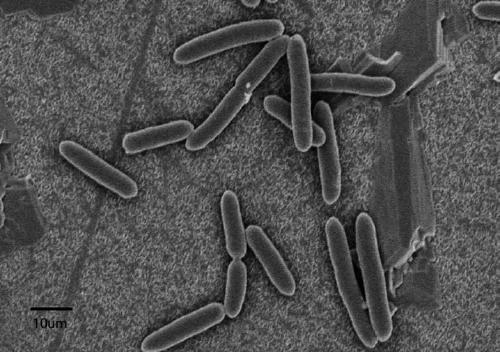Thermophilic bacillus DF7 strain and application thereof
A technology of Bacillus thermophilus and strain, applied in the field of Bacillus thermophilus DF7 strain to achieve the effect of neat edges
- Summary
- Abstract
- Description
- Claims
- Application Information
AI Technical Summary
Problems solved by technology
Method used
Image
Examples
Embodiment 1
[0036] Example 1 Isolation and screening of thermophilic bacillus DF7
[0037] The separation and screening method of thermophilic bacillus DF7 of the present invention is to adopt gradient dilution separation method to obtain, and its method comprises the following steps:
[0038] Sample collection: Samples were taken from the center of the compost matrix after mixed aerobic composting of reed straw and activated sludge according to the volume ratio V / V=2:1.
[0039] Sample pretreatment: Take the above samples and put them into a sterilized container filled with sterile water, seal and shake evenly for 10 minutes, let the suspension stand, take the supernatant and centrifuge, take the upper layer of bacteria as the bacteria suspension, and set aside.
[0040] Enrichment culture: Inoculate 2 mL of the bacterial suspension into 200 mL of liquid medium, place in a constant temperature incubator at 60°C for 48 hours, and obtain culture medium for expanding strains.
[0041] Grad...
Embodiment 2
[0046] Example 2 Identification of physicochemical properties of thermophilic bacillus DF7
[0047] The identification method of thermophilic bacillus DF7 of the present invention comprises the following steps:
[0048] (1) Observe the colony shape and strain shape of the thermophilic strain DF7. The thermophilic bacteria of the present invention were cultured at 60°C for 12 hours. figure 1 shown.
[0049] The thermophilic bacterial strain DF7 of the present invention belongs to the genus Thermobacillus and is Gram positive. figure 2 shown.
[0050] (2) Physiological and biochemical characteristics of the strain
[0051] .
[0052] (3) DNA sequence information and phylogenetic analysis
[0053] MEGA7.0 software was used to display the 16S rDNA sequence phylogenetic tree of the thermophilic strain DF7 and related strains by the adjacent connection method, and the similarity calculation was repeated 1000 times. image 3 The middle growth tree node only displays values ...
Embodiment 3
[0054] Example 3 Lysis test of thermophilic bacillus DF7
[0055] using plateau growing E. coli as the model strain for the experiment. E. coli The culture solution was collected by centrifugation at 5000rpm for 10min and resuspended. 50% (V / V) of thermophilic bacteria (Abs 600 =1.0~1.5) Thermophilic Bacillus ( Bacillus Thermocopriae ) DF7 supernatant was added to the lysis system. Finally, 100mL of mixed bacterial solution was added to a 250mL Erlenmeyer flask and treated at 60°C for 16h, the results were as follows: Figure 4 shown.
[0056] Depend on Figure 4 It can be seen that with the increase of time, E. coli The cell lysis rate continued to increase and reached a maximum of 67% at 14 hours. It shows that the hydrolase secreted by thermophile DF7 will E. coli The cells are lysed, the intracellular organic matter is released, and the content of soluble organic matter in the supernatant increases.
[0057] It can be seen that the protease and amylase secrete...
PUM
 Login to View More
Login to View More Abstract
Description
Claims
Application Information
 Login to View More
Login to View More - R&D
- Intellectual Property
- Life Sciences
- Materials
- Tech Scout
- Unparalleled Data Quality
- Higher Quality Content
- 60% Fewer Hallucinations
Browse by: Latest US Patents, China's latest patents, Technical Efficacy Thesaurus, Application Domain, Technology Topic, Popular Technical Reports.
© 2025 PatSnap. All rights reserved.Legal|Privacy policy|Modern Slavery Act Transparency Statement|Sitemap|About US| Contact US: help@patsnap.com



